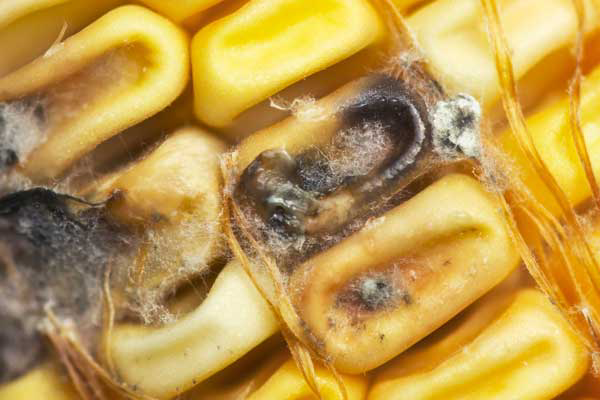The effect of the mycotoxin deoxynivalenol per species

Produced by Fusarium graminaerum mould, DON is part of the Type B Trichothecene family. At high risk levels, DON can have negative impacts on animal health and productivity, such as a reduction in milk production and weight gain, gut irritation and lower immune response.
Critical factors for Fusarium mould growth include heavy rainfall, moderate temperatures, plant immaturity and crop stress or damage from insects, hail and wind. The effects can be detrimental for different animal species.
DON in broilers
The mycotoxin deoxynivalenol (DON) is one of the most common contaminants in poultry feed worldwide. Recent data on global mycotoxin occurrence showed that 59% of 5,819 samples of animal feed tested positive for the presence of DON. The European maximum guidance level for poultry feed is set at 5,000 µg/kg feed. It has been suggested that concentrations higher than 5,000 µg/kg feed are necessary to negatively influence the growth performance of broilers. As a consequence of the negative effect of DON on the intestine, feeding DON-contaminated diets can lead to greater susceptibility to enteric infections. It was hitherto unknown, whether the intestinal epithelial damage caused by contamination levels of DON below 5,000 µg/kg in feed, may act as an additional predisposing factor in broiler necrotic enteritis.
DON in pigs
Pigs are especially susceptible to its negative effects of DON relative to other livestock species. A study was carried out to determine if the negative effects observed with feeding DON contaminated diets could be mitigated by feeding a clay binder and/or spray-dried animal plasma (SDAP). It was shown that pigs fed a DON contaminated diet plus SDAP performed as well as those consuming a non-contaminated diet in terms of ADFI and ADG.

Is there a silver bullet to eliminate mycotoxins?
There is a lot of information to be found on this subject in All About Feed and on the website. This whitepaper gives you a recap and looks into some of the major symptoms in different animal species. We also look at the strategies that can be used to prevent and eradicate them. To read the white paper on mycotoxins click here
DON in cattle
The effects of mycotoxins in cattle may vary from reduced weight gains or milk production. Mycotoxins are detoxified or altered in the rumen. But: The rate of detoxification differs for the different types of mycotoxins and the extent of detoxification of any particular mycotoxin depends on the rate of passage of feed. The extent of detoxification also depends on the original dose level. Five and 10 ppm DON can be completely transformed to the reportedly less toxic deepoxy DON or DOM-1 within 24 hours when incubated in rumen fluid. Studies showed that more than half of the DON remained from the 50 and 100 ppm DON treatments at 24 hours incubation. The altered metabolite(s) may be more toxic than the original mycotoxin.











